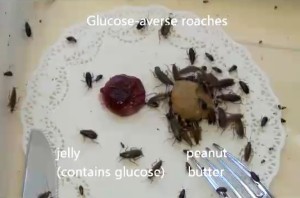Cockroaches can sense danger in sugar

This image made from video provided by Ayako Wada-Katsumata shows glucose-averse German cockroaches avoiding a dab of jelly, which contains glucose, and favoring the peanut butter. For 30 years, people have been getting rid of cockroaches by setting out sweet-tasting bait mixed with poison. But in the early 1990s, a formerly effective product stopped working. Some cockroaches had lost their sweet tooth, rejecting the corn syrup meant to attract them. Later studies showed they were specifically turned off by the sugar glucose in the syrup. Scientists reported Thursday, May 23, 2013, that the key is an altered behavior of certain nerves that signal the brain about foods. AP PHOTO/AYAKO WADA-KATSUMATA
WASHINGTON—Cockroaches will eat anything. Except sugar, that is.
Some of the common pests have evolved to learn how to detect and avoid a certain kind of glucose often used in bait traps, according to research published in the US journal Science on Thursday.
Scientists focused on the slender and small brown German cockroaches, which live all over the world in homes, offices and apartment buildings—anywhere humans tread and leave crumbs behind.
An apparent disdain for sweet-laced traps was first observed in some of these roaches in the early 1990s, about seven to eight years after commercial traps using glucose came on the market and entered into widespread use, said researcher Coby Schal of North Carolina State University.
The roaches were evolving quickly, scientists found. New generations were emerging that had inherited a genetic aversion to glucose.
And now, Schal says he and his colleagues understand why.
Glucose-averse roaches use their small taste-hairs to sample food first and if it contains glucose, they actually taste it as bitter, not sweet.
“They bounce back as if they got an electric shock. It is a very, very, very clear behavior. They just absolutely refuse to ingest it,” said Schal, a professor of entomology.
“It is kind of like if you put something really bitter or really sour in your mouth and you immediately want to expel it.”
Schal said this evolution came about “incredibly fast,” but noted that the development of antibiotic resistance in bacteria moves even faster.
It is hard to know what percentage of roaches have become averse to glucose. In this study, Schal and colleagues sampled various roaches from infestations in the United States, Russia, Puerto Rico and South Korea.
Of 19 populations studied, they found seven that contained glucose-averse roaches in their midst.
“This is a global phenomenon. It is not restricted to the US,” he said.
Professional exterminators have known about the issue for some time. The agrochemical industry has responded by altering baits to replace glucose with other attractants.
“We haven’t used any kind of trap that used sugar for years,” said Bob Kunst, president of Fischer Environmental, a pest control company in Louisiana.
Kunst, who was not involved in the study, described German cockroaches as “filthy little creatures” because they can carry salmonella.
Many of the major players in the pesticide industry keep their attractants under wraps for competitive purposes, but experts have a good idea of what works these days, he said.
“I would suggest certain high carbohydrate and base proteins are very popular with roaches,” Kunst said.
To illustrate how keen these newly evolved roaches are to survive and thrive without glucose, Schal and colleagues filmed the critters as they chose a fructose-based blob of jelly over one right next to it that contained glucose.
They also captured video of the roaches entirely avoiding a mound of jam containing glucose and flocking instead to a glob of peanut butter.
“We are showing that cockroaches can learn incredibly well. They can associate the punishment of tasting glucose with the smell of the bait.”
Schal said he hopes the agrochemical industry will take steps to more widely eliminate glucose from baits.
The German cockroach represents just one of about 5,000 species of roaches, and getting rid of the household pests all together would not be a bad thing, he said.
“As far as we know they do nothing for the ecological system outside of being pests in our homes, associated with us and possibly transmitting diseases and such,” he told AFP.
“In low-income housing it is a really severe problem. Cockroaches are responsible for a huge problem with allergic disease and asthma so it is really critically important to control them, to eliminate them.”
Other types of roaches in the world can be quite useful, from pollinating plants in the tropical rainforest to serving as a key food group for desert scorpions and shrews, he said.—Kerry Sheridan














